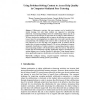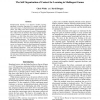411 search results - page 22 / 83 » Using context to improve protein domain identification |
BMCBI
2010
14 years 12 months ago
2010
Background: Flavin binding proteins (FBP) plays a critical role in several biological functions such as electron transport system (ETS). These flavoproteins contain very tightly b...
ITS
2010
Springer
15 years 4 months ago
2010
Springer
Collaborative activities, like peer tutoring, can be beneficial for student learning, but only when students are supported in interacting effectively. Constructing intelligent tuto...
109
click to vote
ICONIP
2008
15 years 1 months ago
2008
Mass spectrometry (MS) is a key technique for the analysis and identification of proteins. A prediction of spectrum peak intensities from pre computed molecular features would pave...
105
click to vote
BMCBI
2010
14 years 12 months ago
2010
Background: Detection of common evolutionary origin (homology) is a primary means of inferring protein structure and function. At present, comparison of protein families represent...
AIIDE
2006
15 years 1 months ago
2006
Reinforcement learning is an effective machine learning paradigm in domains represented by compact and discrete state-action spaces. In high-dimensional and continuous domains, ti...


